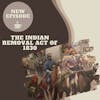Anna Kingsley

I am back with another listener request!
Anna Kingsley was a slave woman who went on to become property and slave owner who won a monumental court case during a period when women and former slaves were given little, if any, agency or respect.
Much of Anna's life remains a mystery, but what we do know is quite fascinating. Tune in this week as I dive into the life of Anna Kingsley.
Thank you to my dear friend and fellow podcaster for requesting I cover Anna Kingsley. For any of you interested in history, especially presidential history, I cannot recommend Jerry's podcast enough. Take a look at his website www.presidenciespodcast.com to tune into his show or look for Presidencies of the United States wherever you get your podcasts!
SOURCES
“Anna Kingsley: A Free Woman.” National Park Service. Last Updated March 2, 2023. (LINK)
“Kingsley Plantation.” National Park Service. Last Updated March 7, 2023. (LINK)
“Life Story: Anna Madgigine Jai Kingsley.” Women & the American Story. (LINK)
Tilford, Kathy. “Anna Kingsley: A Free Woman.” OAH Magazine of History 12, no. 1 (1997): 35–37. http://www.jstor.org/stable/25163192.
Schafer, Daniel L.. Anna Madgigine Jai Kingsley: African Princess, Florida Slave, Plantation Slaveowner. United States: University Press of Florida, 2018.
Welcome to Civics and Coffee. My name is Alycia and I am a self-professed history nerd. Each week, I am going to chat about a topic on U.S history and give you both the highlights and occasionally break down some of the complexities in history; and share stories you may not remember learning in high school. All in the time it takes to enjoy a cup of coffee.
INTRO MUSIC
Hey everyone, welcome back.
Hidden in the documents and contracts found in the historical record lies the story of an African slave woman. The details of her life have to be pieced together by reading through the minimal official documents that remain, but the picture that develops upon inspection is fascinating. And she remains such an understudied woman from history.
If you’ve been a listener to the podcast for any extended period, then you have likely heard me sing the praises of my fellow podcaster and history friend, Jerry over at the Presidencies of the United States. Jerry was one of the first members of the historical podcasting community to welcome me and has been such a wonderful friend, advisor, and sounding board as this podcast has come into its own. Well, dear listeners, my pal Jerry reached out and asked that I look into and cover the life of Anna Kingsley. A woman purchased in a slave market in Havana, Anna would go on to establish her own plantation and secure a legal victory in an era when black bodies were shut out from the legal process.
So this week, I am diving into the life and times of Anna Kingsley. Who was she? And why is her story so unique?
Grab your cup of coffee, peeps. Let’s do this.
As I mentioned at the start of the episode, much of Anna’s life has to be pieced together through the available official records that governed her life. To date, no journals or letters have been uncovered that would help illuminate the thoughts and motivations of the woman who would challenge gender and racial norms. Thus, her story is truncated. With that being said, let’s begin.
The woman who would go on to become Anna Kingsley was born Anta Majigeen Ndiaye (n DIE eh) in 1793. I am fairly certain I did not do any justice to that pronunciation - my apologies. Anta was born in Senegal on the west coast of Africa and Family lore has it that Anta was born into African Royalty and that her sale and transportation to the United States came as a result of a trade by her father. And while there is circumstantial evidence Anta may have, in fact, been part of a royal family, there are no definitive records confirming her station. Whatever her origins, Anta was either traded or captured and placed on a cargo ship, one of the thousands of Africans forced into the tiny spaces allotted during the Middle Passage.
She arrived on the shores of Havana, Cuba in 1806 where she was purchased by plantation owner, and her future husband, Zephania Kingsley. And here, dear listeners, is where I want to pause for a moment and set up the rest of the episode.
While much scholarship has focused on marriage between enslaved individuals, I was unable to locate much information about the prevalence of marital unions between quote unquote master and their human property. This makes me believe the practice of marriage between owner and slave was fairly uncommon. Given that African slaves were seen and treated as chattel, I find it feasible that marriage would be infrequent, especially when factoring in the potential monetary benefit by facilitating marriage between slaves who could produce children to work the land. Additionally, when you factor in the increasingly racist sentiments about the abilities and capacity of black individuals, it makes sense that marriage between slave and master would be the exception and not the rule. Lastly, there would be no benefit that I can think of for a slaveholder to marry their slaves. As property, slaveholders were legally able to do whatever they wanted and so marriage seems like an odd choice to make.
Though Zephania consistently referred to Anta as his wife, he admitted that the union was not sanctioned by the church and therefore largely unrecognized. This assessment, of course, fails to consider how Anta may have felt about the situation. While marriage at a young age was not uncommon, her thoughts about her lack of agency in determining who she would marry remain unknown. So while I will refer to the situation between Zephania and Anta as a marriage for the duration of the episode, I do so in acknowledging that this fails to capture and address the complex nature of their union.
Anta was one of three women bought during Kingsley’s trip. It was during this purchasing excursion that Anta and Zephania were married. Anta was 13. Zephania 41. The details of their wedding are also a bit mysterious. Kingsley referred to marrying his slave bride in a foreign land, leading to some of the earlier rumors that Anta’s sale was an approved trade by her royal father. However, historians believe that the marriage, as it was, likely took place in Cuba before Kingsley made sail back towards his Florida estate.
However, Anta was not the only woman Kingsley took as a bride. In a story that gets stranger by the minute, Anta, who upon her arrival in the United States became Anna, was just one of several slave wives. However, as the first wife, Anna was considered the senior spouse, and therefore enjoyed more authority and respect within the household. Spending a portion of her youth in Africa, Anna would not have been a stranger to polyamorous marriages as they were common amongst various tribal nations. And for his part, Zephania Kingsley appeared to be someone who, while claiming ownership of other human beings, advocated for their humane treatment. He felt it was important to allow enslaved individuals to continue their traditions and customs and supported slaves living together in family units.
Whatever the dynamics of their relationship, it seems as though Zephania trusted Anna’s abilities to run the plantation and oversee the property in his absence. Kingsley continued to increase his land holdings throughout their marriage, including four plantations and roughly sixty slaves. He expanded into opening a successful mercantile and shipping business, which took him away from the plantation often. In his absence, Anna was left to oversee the property and manage the other slaves, a task her husband found her well suited for.
Their marriage produced four children, three of which were born before Anna’s 18th birthday and eventual manumission. Five years after her purchase, in March of 1811, Zephania Kingsley signed an emancipation order freeing his child bride and their three children who were 3, 20 months, and 1 month old at the time. Anna continued to live on the plantation set along the St. John’s River for another year, before she petitioned the Spanish government for a tract of land just across the waterway. As Florida was still under Spanish control at the time, Anna enjoyed much more freedom and rights as a free person of color. Under Spanish law, slavery was not treated as a lifetime sentence of servitude. In fact, Spanish law actively encouraged and supported manumission efforts and, once free, former slaves could own land, testify in court, and enter into legal contracts. And so, with her three children in tow, Anna Kingsley set up on her own plantation just across the river from her former owner and current spouse.
Like her husband, Kingsley purchased livestock and slaves to manage her property. She was one of an increasing number of free Africans living in East Florida and was one of many who secured their freedom only to turn around and purchase others. It is estimated that Anna owned twelve slaves, made up of two men, three women, and seven children. She sold poultry and other goods to her neighbors to earn a living, however it is likely that she continued to be supported by her husband as the five acre tract would not have been sufficient to fully support her family of four. And if you know your early American history at all, then you know that the federal government had trained its eye on acquiring the Florida territory hoping to further expand its borders and influence. The United States sent troops into the territory in 1812 to try to overrun the Spanish government, however were initially unsuccessful. Despite this failure, Anna Kingsley was concerned about the safety of herself and her family and decided to flee the area. Prior to making her escape, Kingsley set her property on fire, denying American invaders the use of her home as a place of rest or protection from the elements.
Vacating the territory on a Spanish gunboat, Kingsley headed towards Haiti, a place she apparently referred to as the Island of Liberty. Considered a safe haven for black and brown individuals since the revolution in 1804, Anna felt her family would be safer and far away from the reach of the American military. The plan was to set up another plantation and to bring enslaved individuals to work as indentured servants, as slavery was against Haitian law. She eventually returned to Florida with her husband and the two continued to work his plantations and oversee household slaves. The United States finally succeeded in acquiring Florida in 1821 and, upon signing a treaty with the Spanish, agreed to respect the rights of free black individuals. This turned out to be a false promise and one that would be repeated when the government signed the Treaty of Guadalupe Hidalgo in 1848. Much like the agreement with the Spanish, the United States agreed to respect the individual rights of Mexican nationals residing within the territory acquired. As you know from my episodes on the Mexican American war and Polk presidency, this isn’t an agreement the government honored.
Zephania Kingsley was appointed to the territory’s legislative council in 1823. During his tenure, Kingsley tried to persuade the federal government to adopt similar laws and customs regarding slavery and the practice of manumission. He felt the U.S should follow Spanish tradition in allowing for the emancipation of slaves and the granting of rights for the free black population. He went so far as to author a pamphlet in 1828 outlining his opinions, however his pleas fell on deaf ears. Too many in power were concerned about the potential of slave revolts and pointed to this as a reason to deviate from past practice.
The Kingsley’s had one last child in 1824, a son named John Maxwell Kingsley. Though they seemed to live in separate residences, the marriage remained intact until Kingsley’s death in 1843 at the age of 78. In his will, Kingsley left his estate to his senior wife and former slave, Anna. However, this was completely unacceptable to Kingsley’s white siblings. Not willing to see their brother’s massive property holdings fall into the hands of a black woman, Kingsley’s sister filed a suit challenging the contents of the will and asked for the courts to award the estate to her instead. Against all odds, the courts decided against Kingsley’s white relatives and ruled the will to be enforced as written.
Thinking of the time period of the lawsuit and the situation at stake - the decision is all the more revolutionary. This wasn’t New England. This was Florida. In the antebellum south. This was not an area known for its protections or support of black and brown bodies and so it makes Kingsley’s win that much more amazing. For her part, Anna used her hew comfort to establish herself along the St. John’s River in the newly named Jacksonville. Despite her legal victory, tensions continued to escalate in Florida as the country moved closer and closer to turmoil and as the Civil War broke out in 1861, Kingsley had a decision to make. She supported the Union and therefore knew staying in Florida would likely lead to a bad outcome. Thus, she packed up and headed north, temporarily settling in New York. Again, without preserved journals or letters, we do not know where Anna stayed or what her thoughts were on settling into such a different environment than the one she grew up in. What we do know is that Anna spent a brief period in the northern city before setting up residence in union held Fernandina and only returned to her home along the St. John’s River once she felt it was safe to do so.
She moved back in 1865 and, like so many others who built their wealth on land ownership and human bondage, found herself economically wiped out. Anna had no funds and no way of earning a living, prompting her to move in with her daughter until her death in 1870. She was buried in the family cemetery in either May or June of the same year. Her former residence and the plantation she used to oversee now serves as an ecological and historical site, and became a part of the Florida Parks Service in 1955. The plantation is open for visitors as of this recording in 2023.
Although historians are left with an incomplete picture, the story of Anna Kingsley is quite extraordinary. A woman who was enslaved as a young girl, forced into marriage with her owner and who went on to become a property owner herself generates so many questions that may forever remain unanswered. Why did Anna stay in Florida once she secured her freedom? Was it an economic decision? Or was there something else at play in her relationship with Zephania? Why prompted Anna to leave New York after the war? Was it to be reunited with her children? Or just the comfort of a familiar place? Unfortunately, we may never truly know the woman beyond the official records capturing her life. And to think of what it could bring to light.
A big thank you to dear friend and long time supporter of the podcast Jerry for recommending I check out the life of Anna Kingsley. As always, I am blown away by how much I learn and discover when researching these topics and they are some of my favorite episodes to put together. And if you are a lover of history, especially presidential history, then I will end this episode with a plug for my friend Jerry and his delightful podcast The Presidencies of the United States. Jerry crafts a narrative that is so thorough and thoughtful and has recently added to his repertoire by adding in a special series, A Seat at the Table, which recounts and ranks the lives of previous cabinet members. It is one of my all time favorite podcasts and know you will find it fascinating too. I will include a link to his podcast in the show notes for this episode.
And, of course, if you ever have a topic you want me to cover, let me know. You can find me on the socials or through my website at www dot civics and coffee dot com.
Thanks peeps. I’ll see you next week.
Thanks for tuning and I hope you enjoyed this episode of Civics & Coffee. If you want to hear more small snippets from american history, be sure to subscribe wherever you get your podcasts. Thanks for listening and I look forward to our next cup of coffee together.
OUTRO MUSIC
Listener Favorites
Not sure where to begin? Take a listen to some fan favorites.

























